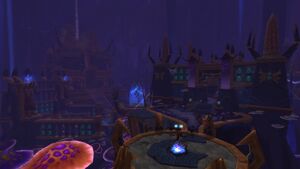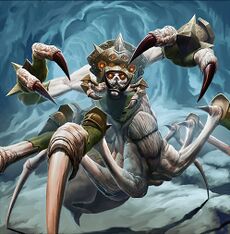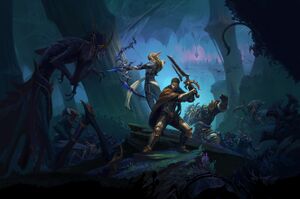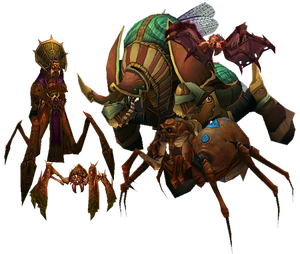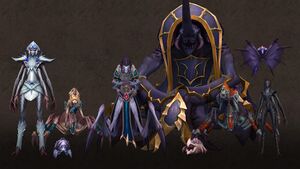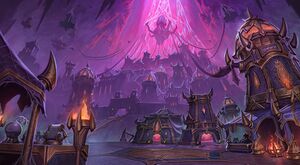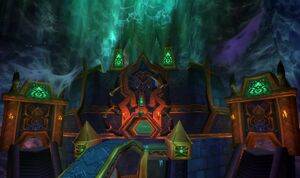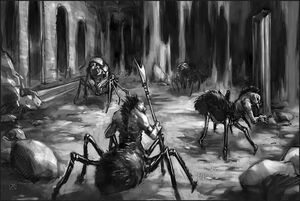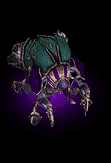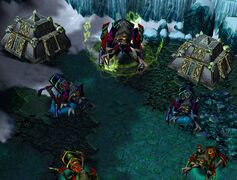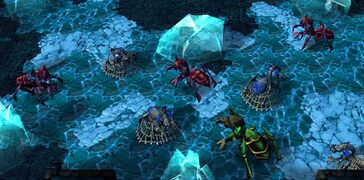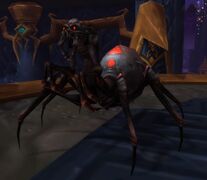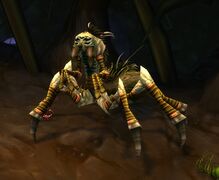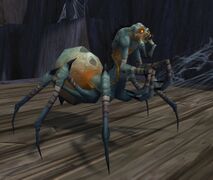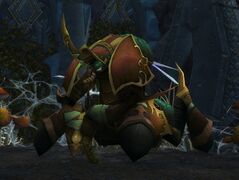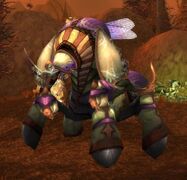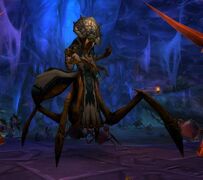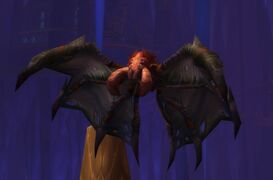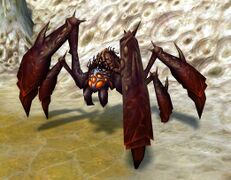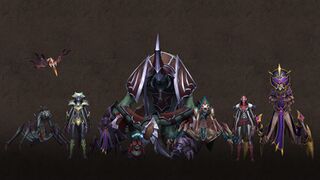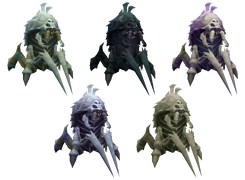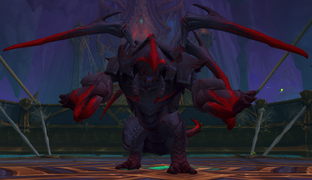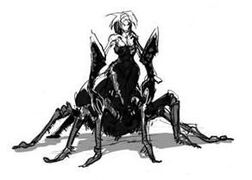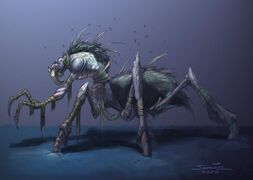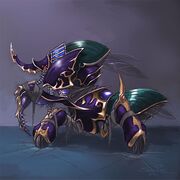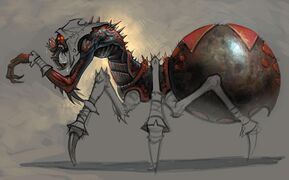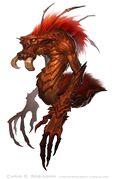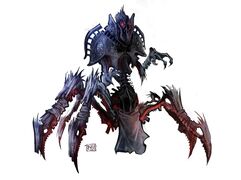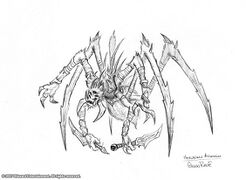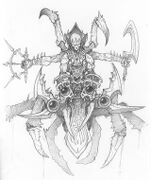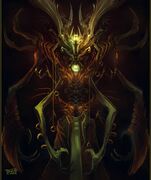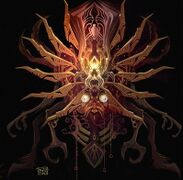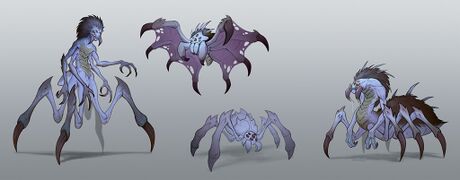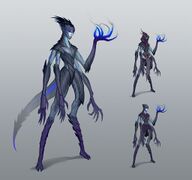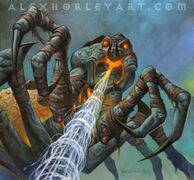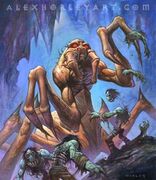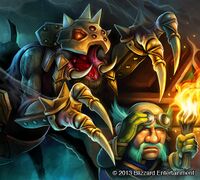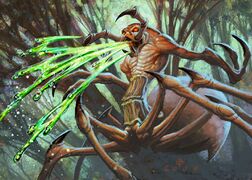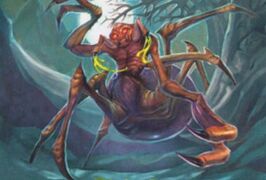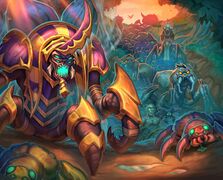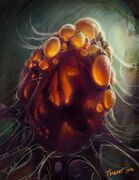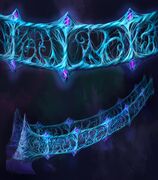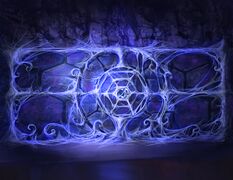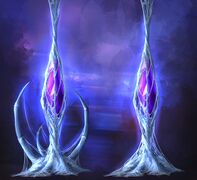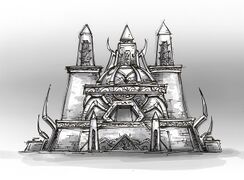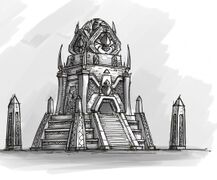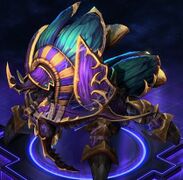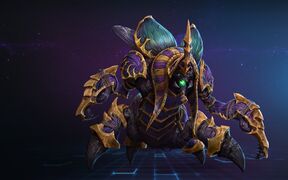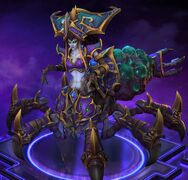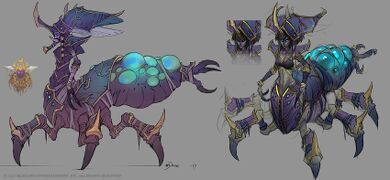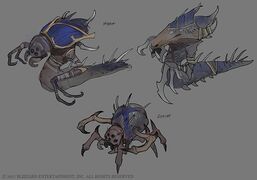Nerubian
| Nerubians | |
|---|---|
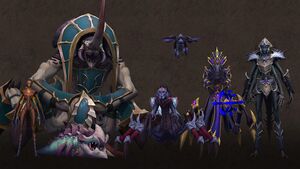 | |
| Faction/Affiliation | Kingdom of Azjol-Nerub, Azj-Kahet, Scourge |
| Character classes |
Living: Worker, Warrior, Seer, Sorcerer, Venomancer, Webspinner, Vizier Undead: Crypt lord, Crypt fiend, Necromancer |
| Racial capital |
Azjol-Nerub (Northrend) City of Threads (Khaz Algar) |
| Racial leader(s) |
|
| Homeworld | Azeroth |
| Language(s) | Nerubian, Common |
“Unhhh-tikk-a-shisss. Kka shir. Na-l bkah a-shisss. Kreesh kik ik ta. Sohk-a tik hiss a-k-k-k.”
- — Writing on a nerubian scroll[2]
Nerubians are an ancient race of evil and highly intelligent humanoid spiders[3][4] that inhabit the subterranean kingdoms of Azjol-Nerub in Northrend and Azj-Kahet in Khaz Algar. Like the qiraji of Kalimdor and the mantid of Pandaria, they are descendants of the aqir race. Unlike their relatives, the nerubians rejected their former Old God masters.[5]
The nerubians' dark empire of Azjol-Nerub once stretched like a great web[6] beneath half the breadth of Northrend.[3][4] During the War of the Spider, the Undead Scourge destroyed Azjol-Nerub and converted many of its inhabitants into undeath (mainly as crypt fiends and crypt lords), leaving only a few pockets of living nerubians who sought to gain vengeance on the Lich King and reclaim their kingdom[6] from both the undead and the minions of the Old God Yogg-Saron.
On the other side of the world, Azj-Kahet—the last nerubian kingdom—remained in isolation deep within Khaz Algar until recent times, when they and their queen, Ansurek, were conscripted by Xal'atath to serve the Void once more and rise to pose a threat to all of Azeroth.[5]
History
Origin
During the war between Azj'Aqir and the Empire of Zul, circa 16,000 BDP, a colony of aqir traveled to Kalimdor's northern wastes (modern-day Northrend), where they discovered a small society of titan-forged tol'vir dwelling outside Ulduar. The aqir overthrew the tol'vir, enslaved them and turned them into obsidian destroyers, and adopted their architecture for their own purposes. Shortly after, the Drakkari troll tribe traveled north to hunt the aqir. The Drakkari were nearly overpowered by the obsidian destroyers, before devising ways to topple and destroy them.[7][8]
The Empire of Zul eventually destroyed Azj'Aqir and contained the aqir in separate colonies in the far north and far south of Kalimdor.[8][9][10] The ones in the north gathered near the underground prison of the Old God Yogg-Saron. Their proximity to the Old God caused them to gradually evolve into a new race, the nerubians, and their kingdom became known as Azjol-Nerub.[8] The heart of the old nerubian empire is Ahn'kahet, the Old Kingdom,[11] which Kilix the Unraveler calls "Ahn'kahet, from whence we came"[12] and "the city of our ancestors".[13]
For some length of time, the nerubians were servants of Yogg-Saron. The Archives of Eternity in Uldir can replicate the minions of individual Old Gods; Yogg-Saron's take the form of voidweavers from Azjol-Nerub.[14] However, at an unknown point in time, the nerubians rejected their Old God masters.[5] By the time of the Third War, the nerubians had come to believe that the faceless ones—another race of Old God servants—were only legends.[15]
Early history
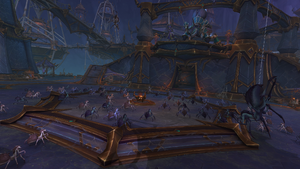
The vrykul Magnar Icebreaker earned his surname from his battles against nerubians in Northrend. While hunting nests of the insectoids, Magnar discovered that cracks in glacier walls could be turned into tunnels that allowed him to dig deep into enemy strongholds and launch surprise assaults on them from within. Years later, remnants of the nerubian armies once again began emerging from their caves, seeking to seize Ulduar and the titan machinery within it. Magnar, now a king wielding the Scale of the Earth-Warder, led his people against the insectoids, pushed them back to the entrance of Azjol-Nerub itself, and defeated them so thoroughly that they ceased all aggression for millennia.[16]
When Northrend split off from Kalimdor during the Great Sundering, the nerubian empire became isolated from the rest of Azeroth but continued to thrive.[17] The nerubians kept to themselves in the darkness of their homeland, being mostly uninterested in the affairs of surface dwellers.[18] Their hidden empire[19][20] stretched nearly half the breadth of Northrend,[3][4] at least as far southwest as the Borean Tundra[21] and as far northeast as the Icy Depths in Icecrown.[22] The seat of the kingdom was located beneath the Dragonblight.[23][24]
At an unknown point in time, another nerubian empire was established in Azj-Kahet at the bottom of Khaz Algar, far to the south of Northrend. Isolated in the deep darkness, these nerubians developed their own culture and to this day represent the race as it originally was—deadly survivors of the mythic wars that have played out time and again over millennia.[5]
War of the Spider
- Main article: War of the Spider
“Then the master came. As his influence spread, we made war upon him, foolishly believing we stood a chance. Many of us were slain and raised into undeath. In life I was a king. Today I am a crypt lord.”
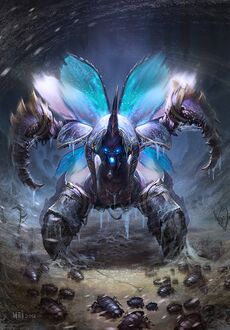
Thousands of years later, the Lich King arrived in Northrend and began enslaving its inhabitants to create his army, the Undead Scourge. The nerubians, who were immune to both the plague of undeath and the Lich King's telepathic Domination, fought back and used their vast forces and underground network to launch hit-and-run attacks on his strongholds, igniting the War of the Spider. After a years-long war of attrition, the Scourge invaded Azjol-Nerub, slaughtered the nerubians, raised them as undead (mainly as crypt fiends and crypt lords), and forced them to serve the Lich King.[3][4][18][26] The Lich King raised Anub'arak, the last king of Azjol-Nerub, as a crypt lord and forced him to help kill his own people and conquer their strongholds (such as Naxxramas) for the Scourge. For this, the living nerubians began to refer to Anub'arak as the "Traitor King" and blame him for the destruction of their kingdom.[27][28]
Many nerubians tried to escape the Scourge's invasion by tunneling underground, but some of them dug too deep and inadvertently exposed tendrils of Yogg-Saron. The Old God sent its faceless ones against the spider-men, who were unable to fight on two fronts and consequently lost both the war and their home.[13][29][30]
As a testament to their resistance, the Lich King adopted the nerubian architectural style as his own and repurposed their ziggurats as flying necropoli.[3][4][26] Most nerubians were killed in the War of the Spider, but small groups of survivors managed to flee deep underground[18] or into the wastes of Northrend.[6] Only the exposed Upper Kingdom of Azjol-Nerub fell to the Scourge; most of the empire remained closed off and has stayed that way ever since. It's possible that surviving nerubians have since secured the depths and merely await release. Alternatively, the closed parts may be infested by faceless ones.[19]
Third War
The 1st Legion and Dwarven Expedition encountered outposts of living nerubians during their expedition in Northrend shortly before the Third War.[31][32]
The Lich King sent Nerubis[33] crypt fiends to aid Arthas Menethil in the Scourge invasion of Quel'Thalas.[34] They used their webs to pull the high elf dragonhawk riders to the ground[35] and burrowed under the walls of Silvermoon City after the fall of Ban'dinoriel.[36] The Nerubis subsequently stayed in Quel'Thalas to occupy Suncrown Village.[37]
When the Frozen Throne was threatened by Illidan Stormrage, the Lich King sent Anub'arak and his undead nerubian subjects to escort Arthas Menethil to Icecrown. In order to reach Icecrown before Illidan did, Arthas and Anub'arak took a shortcut through the ruins of Azjol-Nerub.[38] Along the way, they encountered and killed several pockets of living nerubian rebels who were still fighting to liberate their kingdom from the Scourge.[11][39]
In the aftermath of the Third War, Scourge crypt fiends continued to haunt several areas in the Plaguelands, notably the Plaguewood, Terrorweb Tunnel, Stratholme,[40] and the Arachnid Quarter of Naxxramas.
Wrath of the Lich King
“We are in the midst of a civil war. At the heart of this world the last living members of my species defend themselves against total annihilation. [...] In Arthas we both have an enemy...”
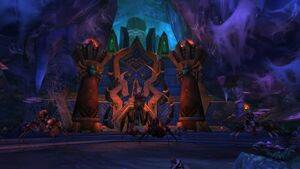
During the war against the Lich King, the Scourged nerubians posed a frequent threat to ground forces in Northrend. Whenever soldiers traveled by land, it was with the thought that the spider-men could burrow up from Azjol-Nerub and attack.[42] The nerubians traveled deep underground using a system of tunnels possibly connecting all the way to Icecrown and linked to the surface through sinkholes,[43][44] allowing them to "spill out from every dark crevice in Northrend".[41]
Meanwhile, a civil war raged in Azjol-Nerub itself, as the Lich King, through his servant Anub'arak, sought to rule the kingdom while its last living inhabitants, the Azjol-anak, tried to defend themselves from annihilation.[41] In the Upper Kingdom, Anub'arak's Scourged nerubians guarded clutches of tainted eggs that would provide them with young that they could kill and raise.[18][45] At the same time, Prince Taldaram led a Scourge army[20] into the Old Kingdom, Ahn'kahet, in search of nerubian relics.[46]
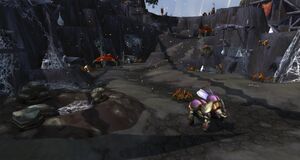
In the Borean Tundra, the Scourged nerubians laid siege to the Valiance Expedition at Valiance Keep until Alliance adventurers collapsed their sinkholes.[43] The Warsong Offensive inadvertently built their base of Warsong Hold atop a well-traversed portion of Azjol-Nerub,[21] allowing the Nerub'ar to overrun the hold's Mightstone Quarry. Horde adventurers fought them back[47] and collapsed their tunnels.[48] Adventurers also worked with the taunka at Taunka'le Village[49] and the gnomes at Fizzcrank Airstrip to halt a Nerub'ar offensive sent to the Geyser Fields[50][51] from the Temple City of En'kilah.[52]
In the Dragonblight, the Anub'ar emerged from the Pit of Narjun and razed the taunka capital, Icemist Village. They acted as one of the Warsong Offensive's main obstacles on their way to the Wrathgate.[53][54] In exchange for assistance against the Scourge, the Azjol-anak (represented by Kilix the Unraveler) provided the Horde with information about the Anub'ar,[55] allowing the Horde to help the taunka retake Icemist from the nerubians.[56][57] Dranosh Saurfang led his forces into Azjol-Nerub and blocked off the nerubians' tunnels into the Dragonblight, preventing them from reinforcing the Scourge at the subsequent Battle of the Wrathgate.[58]
In Zul'Drak, the Argent Crusade were harried by the Hath'ar nerubians and their necromancers.[59][60] In Icecrown, the Argent Crusade attacked Scourgeholme through the Breach, but the Scourge retaliated:[61] large numbers of Scourged nerubians poured out to assault the Argent Vanguard[62] and re-seal the Breach with their webs until the Argents went back on the offensive with the help of adventurers.[63]
Adventurers also entered Azjol-Nerub to deal a blow to the Scourge and help the living nerubians set about restoring their empire.[18] In the Upper Kingdom, they helped Reclaimer A'zak destroy the Scourge's tainted eggs[45] and killed Anub'arak himself.[64] In Ahn'kahet, they helped Seer Ixit's forces reclaim the area from both the invading Scourge[20] and the faceless one servants of Yogg-Saron.[65] These efforts signaled the beginning of the rebirth of the Empire of Azjol-Nerub.[66][67] The eggs the Scourge had found were only a fraction of the living nerubians' hidden stores, which would allow them to repopulate their race.[45] The Kirin Tor acquired Anub'arak's crown and set it aside for whenever the nerubians decided to coronate a new king.[42] The Lich King later raised Anub'arak back into undeath to attack the Argent Tournament, but he was killed again by adventurers.
Battle for Azeroth
During the Fourth War, Alliance and Horde adventurers encountered the Voru'kar, a brood of hostile, living nerubians who had escaped from Azjol-Nerub during the War of the Spider and settled on the Skittering Hollow, an island in the Great Sea. The adventurers killed the Voru'kar's leader, Vorus'arak, and brought his carapace back to Kilix the Unraveler in Northrend.[68]
The War Within
“Even now, the Harbinger gathers the children of the first flesh to reclaim what was lost. They must remember their vows and serve those to whom they owe fealty.”
With the Black Empire destroyed and the Old Gods dead, Xal'atath, the Harbinger of the Void, traveled to Khaz Algar and Azj-Kahet, the last kingdom of living nerubians,[5] to conscript its inhabitants into a new army to bring Azeroth to its knees.[69] She entered a bargain with the nerubian queen, Ansurek, offering her people the opportunity to rise from their isolation and become a powerful kingdom once again. In return for their loyalty, Xal'atath provided a way to evolve chosen nerubians into a new kind of powerful soldiers using dark alchemy. The nerubians began to harvest the blood of the Old Gods within Nerub-ar Palace and have begun a continuous assault against the Arathi humans of neighboring Hallowfall, threatening to overrun their borders. However, not all nerubians agree with Ansurek's alliance with Xal'atath, and they have begun to maneuver against her and Xal'atath's plans.[5]
Biology
Nerubians are sometimes classed as arachnoids[70][71] and other times as insectoids.[16][26] Their young are called spiderlings, and hatch from eggs incubated within breeding pods[39] or the bodies of captured creatures (the host's body bursts apart in the process).[11] Adult nerubians sometimes carry their young with them into battle.[72][73]
Living nerubians are immune to both the plague of undeath and the Lich King's Domination, but their bodies can still be reanimated and controlled through necromancy.[3][4][71]
Undead nerubians are known to eat other humanoids.[74][75]
Types
Nerubians come in several different types, each of which has unique physical traits and a different place in nerubian society.[70]
 Nerubians — Standard nerubians (known as trueborn[76]) resemble a genetic cross between humans and spiders. They have lower bodies supported by six arachnid limbs, and vaguely humanoid torsos equipped with two arms.[25][77] They can move with unsettling speed by quickly scurrying across the ground,[34][78] including across sleek ice that would cause other creatures' feet to slip.[36] They possess venom glands that produce a lethal and incurable toxin.[79] They can project powerful webbing to immobilize creatures[80] or encase them completely them inside cocoons,[61][81][82] holding them helpless until the attacking nerubian can lop off their head with snapping mandibles or impale and eviscerate them with their stiletto-sharp legs.[83] The webbing can be dissolved with the nerubians' own stomach acid.[84] Nerubians raised into undeath by the Scourge are called crypt fiends.
Nerubians — Standard nerubians (known as trueborn[76]) resemble a genetic cross between humans and spiders. They have lower bodies supported by six arachnid limbs, and vaguely humanoid torsos equipped with two arms.[25][77] They can move with unsettling speed by quickly scurrying across the ground,[34][78] including across sleek ice that would cause other creatures' feet to slip.[36] They possess venom glands that produce a lethal and incurable toxin.[79] They can project powerful webbing to immobilize creatures[80] or encase them completely them inside cocoons,[61][81][82] holding them helpless until the attacking nerubian can lop off their head with snapping mandibles or impale and eviscerate them with their stiletto-sharp legs.[83] The webbing can be dissolved with the nerubians' own stomach acid.[84] Nerubians raised into undeath by the Scourge are called crypt fiends.
 Flyers — A small type that can fly using wing-like membranes between their legs.
Flyers — A small type that can fly using wing-like membranes between their legs. Queens — A type that serves as both leaders and mothers to their subjects, and are rumored to be able to genetically pass knowledge from mother to daughter.[85]
Queens — A type that serves as both leaders and mothers to their subjects, and are rumored to be able to genetically pass knowledge from mother to daughter.[85] Spiders — A small, six-legged type.
Spiders — A small, six-legged type. Spiderlords — Colossal behemoths that resemble a mixture between beetles and the other, more spidery nerubians.[25][78] They ruled as the kings of Azjol-Nerub prior to the War of the Spider.[86] Spiderlords raised into undeath by the Scourge are called crypt lords.
Spiderlords — Colossal behemoths that resemble a mixture between beetles and the other, more spidery nerubians.[25][78] They ruled as the kings of Azjol-Nerub prior to the War of the Spider.[86] Spiderlords raised into undeath by the Scourge are called crypt lords. Viziers — Highly intelligent spellcasters who served as advisors and sorcerers to the spiderlords prior to the War of the Spider.[87]
Viziers — Highly intelligent spellcasters who served as advisors and sorcerers to the spiderlords prior to the War of the Spider.[87]
The following types are only found in Azj-Kahet:
- Evolved nerubians — A new kind of nerubians, transformed into paragons of their race and deadly soldiers through a dark alchemical process provided by Xal'atath.[5]
Some bone spiders are considered nerubians.[88] Many scholars believe that all Azerothian spiders trace their roots back to Azjol-Nerub,[89] and the (unreliable)[90] Tribunal of Ages claims that spiders are descended from nerubians.[91] However, it should be noted that spiders unrelated to nerubians are also found natively on many other worlds and planes besides Azeroth.
Groups
- Living
- Azjol-anak — A faction that works with adventurers to reclaim Azjol-Nerub and begin to rebuild the Nerubian Empire.
- Nerubian Guardians — A group that guarded one of the entrances to Azjol-Nerub and were killed by Arthas Menethil and Anub'arak.
- Voru'kar — A hostile nerubian brood, led by Vorus'arak, that escaped from Azjol-Nerub during the War of the Spider and can be encountered on Skittering Hollow.
- Scourged
- Ahn'kahar — A faction found among the Scourge in Ahn'kahet: The Old Kingdom.
- Anub'ar — A faction found serving Anub'arak in the Upper Kingdom and who razed Icemist Village in the Dragonblight.
- Hath'ar — A group led by Malas the Corrupter who survived the crash of the necropolis Kolramas in Zul'Drak and posed a threat to the Argent Crusade in the area.
- Nerub'ar — A faction found attacking Warsong Hold and the Geyser Fields in the Borean Tundra, as well as defending parts of Icecrown Citadel.
- Nerubis — A group of crypt fiends who accompanied Arthas Menethil during the Scourge invasion of Quel'Thalas[33] and now reside in the Ghostlands.
Culture
Nerubians are consistently characterized as "sinister", "evil",[3][4][70] and "wicked".[92] They are monstrously fierce in battle.[26] By nature, they are cruel,[70] fiercely intelligent, and deeply xenophobic, their will dedicated to wiping out any who are not like themselves.[34] Normally highly reclusive and suspicious of outsiders,[71] they usually attack other races on sight, unless they see an advantage in working with them.[70] On the other hand, Brann Bronzebeard claims that the few living nerubians he's met have all been "of a good sort".[28]
Before its fall, Azjol-Nerub was a center of knowledge, art, and learning.[28] The pre-Scourge nerubian culture remains preserved in Azj-Kahet.[5] Only the most powerful nerubian leaders have the capacity for magic, though many Scourged nerubians have become necromancers.[93] Nerubian treasures include items that can seem gruesome or disturbing to other beings, such as a ruby containing tiny imprisoned arthropods struggling to break free[94] or an ornate box containing a living, beating heart.[95] According to Brann Bronzebeard, there is a big difference between living and Scourged nerubian artifacts, with the latter being more unsettling.[96]
Nerubians mummify their dead with burial wrappings,[97] as demonstrated by the mummified and bandaged crypt fiends and crypt lords.[25][77]
Architecture
Nerubian architecture is adapted from that of Northrend's tol'vir.[7] It has been suggested that it may also have been inspired by the necrolords of Maldraxxus, one of the realms of the Shadowlands.[98]
The distinctive nerubian style is elegant, angular,[28] and beautiful, characterized by haunting, vivid colors of blue, purple,[83] green, and gold, some of which fluoresce in low light.[99] They make prominent use of spider motifs and curved stone pillars resembling insect legs,[78] and different rooms and corridors are denoted with intricate geometric shapes.[83] Nerubian towers are called ziggurats.[100] The sacrificial pits of Azjol-Nerub were used long ago to sacrifice enemy forces in exchange for success in battle.[101] Nerubians are crafty engineers: Azjol-Nerub's labyrinthine tunnels are filled with hidden passages,[11] mechanisms, aqueducts, and deadly and sometimes magical traps.[39][102] The denizens stored most of their treasures in hidden hoarding cells.[11] They kept their empire hidden using special ward devices.[20] Azj-Kahet, meanwhile, is dominated by the City of Threads, a sprawling, decaying city which has been built on the ruins of itself many times over, where the wealthiest citizens and those favored by Queen Ansurek inhabit hanging nests and huge palaces above the swarming masses of the many other districts.[5]
After the War of the Spider, the Lich King was so impressed by Azjol-Nerub's tenacious and fearless resistance that he adopted the nerubians' architectural style for his own structures,[3][4][26] in line with the Scourge's philosophy of taking architecture and technology from assimilated cultures rather than generating a culture of their own.[103] The ziggurats of Azjol-Nerub were repurposed as Scourge energy sources and defensive structures,[100] and the Lich King infused some of them with magic to transform them into airborne necropoli,[26] with the most infamous example being Naxxramas.[25] The celebrated Scourge architect Obrahiim took much of his early inspiration from nerubian architecture.[104]
Slavery and pets
The nerubians of Azjol-Nerub kept enslaved tol'vir known as obsidian destroyers. The Scourge claimed the nerubian empire's few remaining tol'vir slaves during the War of the Spider and threw them into the front lines of the Third War, but it's possible that more tol'vir still exist deep within Azjol-Nerub.[7]
According to legend, the nerubians used the giant jormungar worms as creatures of labor and forced them to carve passages through Northrend's subterranean ice to lay the groundwork for Azjol-Nerub's great cities. After the War of the Spider, swarms of the nerubians' jormungar went rogue.[105][106] Scourged nerubians use giant undead worms called Scourged burrowers to create their tunnels.[43]
The nerubians of Azjol-Nerub used arachnathid and spider crabs in some of their traps in order to guard against intruders.[39] Undead crypt fiends command normal spiders and can summon swarms of insects,[77][80] while crypt lords can summon carrion beetles and swarms of locusts.[107][108]
The nerubians of Azj-Kahet domesticate insects as beasts of burden and pets.[5]
Notable
- Living
| Name | Type | Role | Status | Location |
|---|---|---|---|---|
| Nerubian | Leader of the Azjol-anak reclamation of the Upper Kingdom | Alive | Azjol-Nerub | |
| Vizier | Leader of the Azjol-anak reclamation of the Old Kingdom | Alive | Ahn'kahet | |
| Nerubian | Azjol-anak leader in the Pit of Narjun | Alive | Pit of Narjun, Dragonblight | |
| Queen | Queen slain by Arthas Menethil and Anub'arak | Deceased | Azjol-Nerub | |
| Spiderlord | Swarm Lord of the Voru'kar | Killable | Skittering Hollow |
- Scourge
| Name | Type | Role | Status | Location |
|---|---|---|---|---|
| Crypt lord | Traitor King of Azjol-Nerub, majordomo of the Lich King | Deceased | Various | |
| Crypt lord | Prisoner of the Violet Hold | Killable | Assault on Violet Hold | |
| Crypt lord | Leader of the Anub'ar in Icemist Village | Killable | Icemist Village, Dragonblight | |
| Crypt lord | Guardian of Naxxramas | Killable | Arachnid Quarter, Naxxramas | |
| Crypt lord | Would-be new leader of the Scourge | Killable | Ix'lar's Domain, Eastern Plaguelands | |
| Vizier | Guardian of the entrance to Azjol-Nerub | Killable | Gilded Gate, Azjol-Nerub | |
| Vizier | Leader and tutor turned servant of the Scourge | Killable | Hall of the Conquered Kings, Ahn'kahet | |
| Crypt fiend | Ziggurat guardian in Stratholme | Killable | The Gauntlet, Stratholme | |
| Crypt fiend | One of the Scourge's deadliest crypt fiend commanders | Killable | The Caller's Chamber, Razorfen Downs |
As a companion pet
 [Crypt Fiend] and
[Crypt Fiend] and  [Ziggy] can be purchased from Sean Wilkers for
[Ziggy] can be purchased from Sean Wilkers for  [Cleansed Remains].
[Cleansed Remains]. [Nerubian Relic] drops from Anub'arak in the Trial of the Crusader.
[Nerubian Relic] drops from Anub'arak in the Trial of the Crusader. [N'Ruby] is sold by Baron Sliver in the Tyrhold Reservoir for 2750
[N'Ruby] is sold by Baron Sliver in the Tyrhold Reservoir for 2750  .
. [Voru'kar Leecher] can be contained in
[Voru'kar Leecher] can be contained in  [Skittering Hollow Salvage].
[Skittering Hollow Salvage].
In the RPG
History
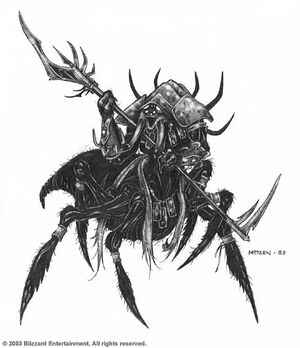
Long before the Sundering, the Gurubashi and Amani empires defeated the empire of Azj'Aqir and split them into two factions, the nerubians in the north and the qiraji in the south.[109] The nerubians arrived in what is now Northrend after the furbolgs and titans did and carved out the vast empire of Azjol-Nerub in the caves beneath the surface[110] after clashing with and claiming many bloody victories against the continent's other natives, especially the Drakkari ice trolls.[111] The furbolgs were apparently aware of Azjol-Nerub, as their songs mention "the many-legged dark", but since the furbolgs didn't go into the caves and the nerubians didn't go above ground, the two races never interacted.[110] Azjol-Nerub extended over much of Northrend. Occasionally, the kingdom kidnapped humans or elves for experimentation, but for the most part the nerubians remained isolated from surface affairs.[109][112] The Icecrown Glacier was their capital.[113]
When the Lich King arrived in Northrend, he immediately saw that the nerubians posed a major threat, as they were the most numerous, organized, and disciplined race in Northrend.[114] The nerubians were unconcerned about the fate of other races but knew that the Lich King's plans threatened their own existence, and hatched elite warriors to attack the Scourge.[109][112] The War of the Spider was long and hard and the nerubians almost won, with ten undead falling for every dead nerubian, but ultimately the endlessly replenished Scourge prevailed. Ner'zhul released the undead plague, destroying Azjol-Nerub in a matter of days. The libraries burned and the surviving nerubians fled. The Scourge raised the dead nerubians as crypt fiends to rebuild their cities and stole their architecture and arcane arts.[109][112][115]
The living nerubians that remain are scattered. Some groups, particularly those in Northrend, seek to rebuild their civilization, while others simply try to get by.[112] A few surviving nerubians are still scattered throughout Azjol-Nerub, with some hiding alone or in small groups, scavenging and killing Scourge whenever possible, while others form larger bands and plot rebellion against the undead. They have cordial relations with the Bronzebeard Expedition in Doorward, mostly leaving them alone and occasionally exchanging information and trading items for food.[115] Small packs of nerubians roam the Borean Tundra[116] and the Dragonblight, where they use dragon bones to take cover from Scourge patrols and make futile plans to reclaim their kingdom.[117] A major nerubian enclave is the Sundered Monolith, buried under the ice of southeast Northrend.[109] There are also scattered nerubian families in northern Kalimdor and a few nerubian settlements throughout Ashenvale.[112]
Appearance
Nerubians have the lower bodies of spiders and smaller upper bodies resembling dark-skinned humans covered in chitin. They have pincerlike claws instead of hands, but have no trouble handling complex tools. Their size depends on the diet assigned to their caste, with workers averaging 10 feet tall and the most ancient queens being able to reach 40 feet.[109] They tend to avoid combat when possible, but are disciplined if forced to fight, preferring quick charges and using simple weapons like spears and javelins. They can deliver a poisonous bite at close range, but prefer the distance that weapons offer. They can emit webs, both as an attack to entangle enemies and for traversal.[109][112] Nerubians often wear a special kind of chitin armor formed from their own molted exoskeletons. The discarded chitin is combined with wood pulp, lacquer, and various alchemical preparations.[112][118] Nerubians can see in the dark up to 60 feet.[109][111]
Society
Castes
Nerubian society is meritocratic and divided into castes, somewhat similar to an insect hive, but without the sense of status or stigma that usually comes with the term. A nerubian's caste is determined in their youth; a worker who shows talent in a given area can join the appropriate caste, though social mobility decreases with age as diet and training will quickly lock them into a specific caste. A nerubian community has a single leader (usually the oldest female), a few advisors, a small guard of warriors, and a large body of workers. Smaller communities are ruled by councils of spiderlords, while larger settlements are ruled by queens. In Azjol-Nerub, there was also a king, Anub'arak. Groups formed for a specific purpose (such as a warband, a trade guild, or a group of decimated families) choose leaders with proven ability.[109][112] Nerubians hatch as spiderlings—small and voracious creatures that can gather in deadly swarms—and become adult at 3 years of age. Adults carry their spiderlings with them on their body while in their lairs.[119]
 Workers are the smallest type and endlessly labor to provide for the needs of the other castes.
Workers are the smallest type and endlessly labor to provide for the needs of the other castes. Seers are counselors and mages who preserve lore and serve as the community's intellectual backbone. The boldest of them are also explorers, and they understand the outside world better than other nerubians.
Seers are counselors and mages who preserve lore and serve as the community's intellectual backbone. The boldest of them are also explorers, and they understand the outside world better than other nerubians. Warriors usually serve as hunters, and are also organized into small bands to patrol a community's defenses.
Warriors usually serve as hunters, and are also organized into small bands to patrol a community's defenses. Webspinners serve as the engines of industry, and are skilled at creating webs which are used for many purposes.
Webspinners serve as the engines of industry, and are skilled at creating webs which are used for many purposes. Spiderlords are holders of law who made up the majority of Azjol-Nerub's leadership. They still serve as leaders in smaller communities, and as advisors to queens in larger communities. Prominent warriors and seers can be elevated to spiderlords as a community grows.
Spiderlords are holders of law who made up the majority of Azjol-Nerub's leadership. They still serve as leaders in smaller communities, and as advisors to queens in larger communities. Prominent warriors and seers can be elevated to spiderlords as a community grows. Queens are the mothers and rulers of the cities, usually advised by spiderlords.[109][112]
Queens are the mothers and rulers of the cities, usually advised by spiderlords.[109][112]
Daily life
At its height, the nerubian civilization was beautiful and cultured, but, by some accounts, cruel. Underground terraced pits and occasional aboveground ziggurats housed countless nerubians living, working, and contemplating the universe. Azjol-Nerub contained huge libraries of literature, music, philosophy, and arcane lore.[109][112] Nerubian architecture resembles a mix of human and insect influences. All surfaces in a nerubian community (including walls and ceilings) are meant to be traversed, and many surfaces are decorated with gemstone-adorned webs. Entrances are covered in thick gossamer barriers that are enchanted to alert the community when breached.[109] The nerubians were thorough artisans and left barely a corner of Azjol-Nerub's tunnels untouched. They polished every edge smooth and widened tunnels into corridors and ceilings while preserving the odd angles created by nature. They nurtured certain phosphorescent lichen and fungi to provide light. They set many deadly traps throughout their home, like hidden pits, trap doors, and statues that shoot frost at intruders.[115] Magic plays an important role in day-to-day life and helps to quicken breeding, heal injuries, watch for threats and game, and protect against Northrend's cold climate (many gems produced by seers are enchanted to provide heat). One of the most distinctive elements of nerubian society is obelisks. In Azjol-Nerub, the nerubians built many enormous obelisks crowned by huge gemstones that served as magical conduits. However, any modern enclave that built one would be effectively inviting an invasion by the Scourge.[109]
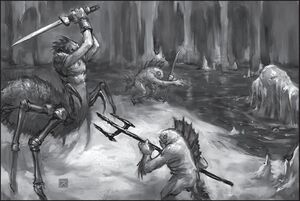
One nerubian community, the Sundered Monolith, is divided into several levels reserved for the different castes. The topmost level is reserved for warriors guarding against the surface and the middle ones for workers and food storage, followed by a library for seers and spiderlords, and finally at the bottom a huge cavern housing the queen and other egg-laying females. The architecture is most insectlike in the workers' quarters and most humanlike in the seers'. Nerubian communities spend much effort on producing food, with workers living on a diet of live maggots and termites while higher castes eat live birds, fish, and small mammals. Whenever possible, game animals are penned in underground enclosures. The closest thing to a nerubian delicacy is an eating practice among the warriors, who produce a sticky but edible line of web, spit venom onto it, and dip it into insect nests before consuming it. Larger nerubian communities also domesticate bane spiders and many other spider types as pets.[109]
Mentality
By the standards of other races, nerubians are a cold, callous people. Though keenly intelligent, they rarely see beyond their caste role, have little imagination, and rarely feel passion or express affection. They often find other races' ideas concerning emotions and culture to be strange and confusing. Their few emotions cause them to tend toward sadism and exercising power for its own sake, and they take satisfaction in paralyzing, torturing, and killing creatures for sport and meat. However, they are not impossible to understand. They do feel attachment and hatred, have a simple understanding of honor, and honor agreements with others. They do not worship logic; their emotions are simply not fettered by "warm-blooded ornamentation".[109][112]
Nerubian minds are different from most races, and their emotionless nature allows them to resist spells that affect the mind. Those who have attempted to telepathically communicate with them have described nerubian minds as "frozen", "like trying to drill through layers of solid ice". This quality also makes them immune to the Lich King's undead plague.[109][112]
Once a race of vigorous philosophers, the fall of Azjol-Nerub has reduced the nerubians to a passionless existence.[109] Where once they were proud, polished scholars and artisans who rarely expressed anger, they are now largely a nervous and almost paranoid people inclined to grief and rage.[115] A typical nerubian now lives out his life, performs his duties, and then dies (often violently), without advancement or hope. That said, they are still driven by the knowledge that the Scourge has wronged them.[109] In their quiet and passionless manner, nerubians despise the Scourge and will take any opportunity to do it harm,[112] even as they realize that they are too weak to overthrow the Lich King and must content themselves with their guerilla war. Nerubians trust and get along with no one. They shun contact with outsiders and tend to kill on first sight, viewing all non-nerubians with suspicion. This makes it difficult for other races to prove that they are also an enemy of the Scourge. It may be possible to convince them to parley if one presents suitable gifts and defers to their military might, but they are nonetheless very dangerous to approach.[109][111] The undead plague is a constant fear for nerubian enclaves, and they kill and burn anyone believed to be infected.[109]
That said, not all nerubians fall into dark ways. Some may join groups of adventurers in the hopes of striking against the Scourge, while other (often young) individuals) may leave their homes because they don't want any part of their people's hopeless conflict and want to become more than survivors. The remote possibility exists that a handful of nerubians are not evil and could get along better with other races than with their own kind.[111] Despite their apparent isolation, there is some evidence that the surviving nerubians maintain a network of magically disguised spies among other races. There are also rumors of wandering nerubian necromancers in Kalimdor (e.g. Mael Shelub), and Brann Bronzebeard believes that some seers may be dabbling in necromancy in the hopes of "beating the Lich King at his own game".[109]
Nerubians may place great store in longevity; nerubians encountered at the Sundered Monolith told Brann Bronzebeard their ages, and they seemed impressed by his.[109] Brann feels that nerubians and dwarves have much in common, as they are both attuned to living underground (although nerubians focus more on the intellectual than the physical), and he believes that the two races could have become strong allies had it not been for the War of the Spider.[115] Nerubians speak their own language, Nerubian, and many are also fluent in Common.[109] They can also learn the languages of creatures they occasionally interact with, such as Draconic, Dwarven, Low Common, Thalassian, and Zandali.[111]
Faith
In ancient Azjol-Nerub, there were five or six schools of religious thought, and theological debates were common. Eventually, however, most nerubians came to the conclusion that worshipping creatures from beyond the world is insane, and, in the words of the seer Ul'Tomon, "Given the intentions of most such entities toward the world, [...] makes as much sense as a fly caught in a web worshipping the spider who is about to devour him". To modern nerubians, even the concept of "worship" itself is alien and confusing. They may revere their queens and their ancestors, but they do not understand the concept of holiness.[109]
Notable
 Azhuul'Mehab — Queen of the Sundered Monolith enclave.
Azhuul'Mehab — Queen of the Sundered Monolith enclave. Mihal — A warrior and one of Brann Bronzebeard's guides in the Sundered Monolith.
Mihal — A warrior and one of Brann Bronzebeard's guides in the Sundered Monolith. Ul'Tomon — A spiderlord and the chief seer of the Sundered Monolith. One of Brann's guides in the Sundered Monolith.
Ul'Tomon — A spiderlord and the chief seer of the Sundered Monolith. One of Brann's guides in the Sundered Monolith. Hazu'Asnab — A spiderlord and owner of a document found by Brann which allowed him passage through the Sundered Monolith.
Hazu'Asnab — A spiderlord and owner of a document found by Brann which allowed him passage through the Sundered Monolith. Majis'Tomon — A spiderlord and the main lawgiver in the Sundered Monolith.
Majis'Tomon — A spiderlord and the main lawgiver in the Sundered Monolith. Mael Shelub — An independent nerubian necromancer, featured in an adventure in Lands of Conflict.
Mael Shelub — An independent nerubian necromancer, featured in an adventure in Lands of Conflict.
Notes and trivia
- Upon encountering nerubians for the first time during the Scourge invasion of Quel'Thalas, both Sylvanas Windrunner[34] and Lady Liadrin were reminded of tales of the aqir. Liadrin correctly guessed the nerubians' origin, namely that vestiges of the aqir must have survived in hidden corners of the world.[36]
- Several armor sets in World of Warcraft are nerubian-themed: the Cryptstalker Armor (hunter tier 3) is created from crypt fiend body parts,[40][120][121] the Ahn'Kahar Blood Hunter's Battlegear (hunter tier 10) is created from crypt lord husks,[122] and the Webbed Saronite Exoskeleton and Webbed Saronite Weaponry (death knight Trading Post ensembles) are themed after nerubian silk.
- Nerubians were originally planned to play a bigger role in the story of Wrath of the Lich King. Azjol-Nerub itself was planned to be a subterranean questing zone before being reduced to the two instances of Azjol-Nerub and Ahn'kahet. Then-vice president of creative development Chris Metzen stated, "There are still pockets of Nerubians down there literally fighting for their lives, and we have any number of plans about how they play into things. What are they about? Are they principled, or even worse in some ways than the Scourge itself?"[123] Notably, the living nerubians were originally planned to be followers of Yogg-Saron[124] (whom players would've encountered in Azjol-Nerub), rather than enemies of it as they are in the final game. At BlizzCon 2007, the nerubians and the Old Gods were described as "B.F.F.".[125] Possible remnants of this scrapped storyline include the pre-release Wrath of the Lich King Bestiary, which mentions that the living nerubian viziers are rumored to serve an "unseen emperor" destined to lead them to a final victory against the Scourge,[87] and the in-game dialogue of Kilix the Unraveler, who mentions a coming "day of reckoning" as well as an "ancient one" who will punish the Anub'ar for siding with the Lich King.
- One of the mount concepts that could be voted on in the September 2020 Choose the Next Shadowlands Mount poll but lost to the
 [Wandering Ancient] was a "Nerubian Swarmer". The mount's backstory would've been that of a Scourge nerubian that was released by the breaking of the Helm of Domination and subsequently repurposed by the Argent Crusade and Knights of the Ebon Blade to hunt rampaging Scourge during the events of Death Rising.[126]
[Wandering Ancient] was a "Nerubian Swarmer". The mount's backstory would've been that of a Scourge nerubian that was released by the breaking of the Helm of Domination and subsequently repurposed by the Argent Crusade and Knights of the Ebon Blade to hunt rampaging Scourge during the events of Death Rising.[126] - Aesthetically, nerubian culture is loosely inspired by ancient Egypt (as seen in their names and mummification practices) and Mesopotamia (as seen in their architecture, particularly their ziggurats). This is most overtly apparent with spiderlords and crypt lords, who wear nemes headdresses and false beards in the style of Egyptian pharaohs and whose names are mostly derived from those of famous Egyptian gods and rulers.
Gallery
- Warcraft games
A crypt fiend in Warcraft III.
A crypt lord in Warcraft III.
A crypt fiend (Classic).
A spiderlord.
A crypt lord.
Lineup of nerubian models in The War Within.
Ulgrax the Devourer, a mutated nerubian.
- Artwork and concept art
Warcraft III concept art of an early, more humanoid design for the crypt fiend, by Travis Thammer.
Warcraft III concept art of a crypt fiend by Samwise Didier.
Warcraft III concept art of a crypt lord by Samwise Didier.
Concept art by Chris Robinson.
"Blackfang" by Trent Kaniuga.
Nerubian assassin concept art by Glenn Rane.
Nerubian concept art by Trent Kaniuga.
Nerubian concept art by Trent Kaniuga.
The War Within concept art of evolved nerubians.
Azjol-anak Champion (TCG).
Azjol-anak Battleguard (TCG).
Azjol-anak Acidspewer (TCG).
Azjol-anak Acidslinger (TCG).
An Unending Swarm of Scourged nerubians (Hearthstone).
Nerubian Egg (Hearthstone).
Building concept art. A hint of qiraji style can be seen.
- Heroes of the Storm
Anub'arak hero artwork.
Concept art of Crypt Queen Zagara's nerubian-themed zerg minions.
See also
References
- ^
 [15-30D] Pupil No More
[15-30D] Pupil No More
- ^
 [Vizier's Scrawled Streamer]
[Vizier's Scrawled Streamer]
- ^ a b c d e f g h Warcraft III: Reign of Chaos Game Manual, Undead History, War of the Spider
- ^ a b c d e f g h
 [War of the Spider]
[War of the Spider]
- ^ a b c d e f g h i j World of Warcraft 2023-11-03. BlizzCon | The War Within: What's Next Panel | World of Warcraft. YouTube. Retrieved on 2024-03-11.
- ^ a b c Warcraft III: Reign of Chaos Game Manual, Creatures of Lordaeron & Northrend, Nerubians
- ^ a b c Ask CDev Answers - Round 1
- ^ a b c World of Warcraft: Chronicle Volume 1, pg. 73 - 74
- ^
 [The Twin Empires]
[The Twin Empires]
- ^ The Troll Compendium: Early Troll Civilization - The Rise of Troll Civilization
- ^ a b c d e Into the Shadow Web Caverns
- ^
 [80H] All Things in Good Time
[80H] All Things in Good Time
- ^ a b
 [76D] The Faceless Ones
[76D] The Faceless Ones
- ^ Zek'voz - Stage Two: Deception
- ^ The Forgotten Ones
- ^ a b Saga of the Valarjar: Scale of the Earth-Warder
- ^ Wrath of the Lich King: The Story So Far
- ^ a b c d e Wrath of the Lich King World Dungeons - Azjol-Nerub
- ^ a b
 [15-30D] The Gatewatcher's Talisman
[15-30D] The Gatewatcher's Talisman
- ^ a b c d
 [15-30D] Reclaiming Ahn'Kahet
[15-30D] Reclaiming Ahn'Kahet
- ^ a b Heart of War
- ^ Anub'arak (Trial of the Crusader tactics)#Quotes
- ^ The Art of World of Warcraft: Wrath of the Lich King, pg. 82: "Within the Dragonblight, the one-time seat of the nerubian empire, dense forests surround an arctic wasteland ..."
- ^ Exploring Azeroth: Northrend, pg. 70: "The seat of the old nerubian kingdom of Azjol-Nerub, long since fallen, sits in the roots of the land [Dragonblight]."
- ^ a b c d e Road to Damnation
- ^ a b c d e f World of Warcraft: Chronicle Volume 3, pg. 29
- ^ Vaeflare 2014-09-30. Anub'arak Hero Week - Heroes of the Storm. Archived from the original on 2020-10-24.
- ^ a b c d Exploring Azeroth: Northrend, pg. 75
- ^
 [80H] Proof of Demise: Herald Volazj
[80H] Proof of Demise: Herald Volazj
- ^ Herald Volazj#Adventure Guide
- ^ Dissension
- ^ Frostmourne (WC3 Human)
- ^ a b Nerubis Vanguards in


 [50-70] The Fall of the Sunwell
[50-70] The Fall of the Sunwell
- ^ a b c d Arthas: Rise of the Lich King, chapter 18
- ^ Key of the Three Moons
- ^ a b c Blood of the Highborne, chapter 2
- ^
 [1-30] Suncrown Village
[1-30] Suncrown Village
- ^ The Return to Northrend
- ^ a b c d The Forgotten Ones
- ^ a b Huntsman Leopold#Quotes
- ^ a b c
 [15-30] An Enemy in Arthas
[15-30] An Enemy in Arthas
- ^ a b
 [80H] Proof of Demise: Anub'arak
[80H] Proof of Demise: Anub'arak
- ^ a b c
 [10-30] Plug the Sinkholes
[10-30] Plug the Sinkholes
- ^
 [10-30] Scouting the Sinkholes
[10-30] Scouting the Sinkholes
- ^ a b c
 [15-30D] Don't Forget the Eggs!
[15-30D] Don't Forget the Eggs!
- ^ Prince Taldaram#Adventue Guide
- ^
 [10-30] Taking Back Mightstone Quarry
[10-30] Taking Back Mightstone Quarry
- ^
 [10-30] Bury Those Cockroaches!
[10-30] Bury Those Cockroaches!
- ^ The Collapse
- ^
 [10-30] Fueling the Project
[10-30] Fueling the Project
- ^
 [10-30] Deploy the Shake-n-Quake!
[10-30] Deploy the Shake-n-Quake!
- ^
 [10-30] Shrouds of the Scourge
[10-30] Shrouds of the Scourge
- ^
 [15-30] Agmar's Hammer
[15-30] Agmar's Hammer
- ^
 [15-30] Victory Nears...
[15-30] Victory Nears...
- ^
 [15-30] The Lost Empire
[15-30] The Lost Empire
- ^
 [15-30] The Might of the Horde
[15-30] The Might of the Horde
- ^
 [15-30] Return of the High Chief
[15-30] Return of the High Chief
- ^ Glory
- ^
 [20-30] Throwing Down
[20-30] Throwing Down
- ^
 [20-30] Death to the Necromagi
[20-30] Death to the Necromagi
- ^ a b
 [25-30] Scourge Tactics
[25-30] Scourge Tactics
- ^
 [25-30] Defending The Vanguard
[25-30] Defending The Vanguard
- ^
 [25-30] Once More Unto The Breach, Hero
[25-30] Once More Unto The Breach, Hero
- ^
 [15-30D] Death to the Traitor King
[15-30D] Death to the Traitor King
- ^
 [15-30D] The Faceless Ones
[15-30D] The Faceless Ones
- ^ Reclaimer A'zak quotes
- ^ Seer Ixit quotes
- ^
 [10-50] Vorus'arak's Carapace
[10-50] Vorus'arak's Carapace
- ^ World of Warcraft®: The War Within™. Archived from the original on 2023-11-17. “Journey through never-before-seen subterranean worlds filled with hidden wonders and lurking perils, down to the dark depths of the nerubian empire, where the malicious Harbinger of the Void is gathering arachnid forces to bring Azeroth to its knees. / Azj-Kahet: The pinnacle of nerubian society where Xal'atath, Harbinger of the Void, has been gathering and mutating nerubian forces to create an unstoppable army.”
- ^ a b c d e Ultimate Visual Guide, pg. 181
- ^ a b c WoW Classic: Naxxramas is Now Live!
- ^ Nerubian Warrior unit and World Editor tooltip: "Light melee unit that carries its young into battle."
- ^ Nerubian Spider Lord unit and World Editor tooltip: "Heavy melee unit that carries its young into battle."
- ^ Anub'Rekhan quotes
- ^
 [10-30] Untold Truths
[10-30] Untold Truths
- ^
 [78-80] Moonlight Gutter Swim
[78-80] Moonlight Gutter Swim
- ^ a b c Warcraft III - Undead -> Units -> Crypt Fiend. Archived from the original on 2009-03-25.
- ^ a b c Arthas: Rise of the Lich King, chapter 23
- ^
 [25-30] Curing The Incurable
[25-30] Curing The Incurable
- ^ a b Warcraft III: Reign of Chaos Game Manual, Undead Units, Crypt Fiend
- ^ Nerub'ar Victim
- ^
 [20-30] Cocooned!
[20-30] Cocooned!
- ^ a b c Arthas: Rise of the Lich King, chapter 24
- ^
 [15-30] Just Encased
[15-30] Just Encased
- ^
 [Scepter of Nezar'Azret]
[Scepter of Nezar'Azret]
- ^ Warcraft III - Undead -> Units > Crypt Lord. Archived from the original on 2009-03-24.
- ^ a b The Wrath of the Lich King Bestiary: Nerubian Vizier
- ^ Carrion Fleshstrippers count toward the objective of
 [25-30] Defending The Vanguard
[25-30] Defending The Vanguard
- ^ Warcraft III: Reign of Chaos Game Manual, The Creatures of Kalimdor, Spiders
- ^ World of Warcraft: Chronicle Volume 1, pg. 65
- ^ World of Warcraft: The Magazine Volume II Issue I, Ancient offshoot lineage chart
- ^ Archaeology interface description
- ^ The Old Wizard's Almanac
- ^
 [Infested Ruby Ring]
[Infested Ruby Ring]
- ^
 [Gruesome Heart Box]
[Gruesome Heart Box]
- ^ Exploring Azeroth: Northrend, pg. 47
- ^ Blizzard Entertainment 2020-01-15. Tales from the Smithy: Reforging the Undead. Archived from the original on 2020-03-12. “The reforged Crypt Fiend regains its missing legs, along with burial wrappings to represent its mummified origins, and a truly terrifying visage.”
- ^ JudgeHype 2020-11-19. Interview de Steve Danuser sur l'histoire de Shadowlands. Archived from the original on 2022-02-14.
- ^
 [Six-Clawed Cornice]
[Six-Clawed Cornice]
- ^ a b Warcraft III: Reign of Chaos Game Manual, Undead Structures, Ziggurat
- ^ Warcraft III: Reign of Chaos Game Manual, Undead Structures, Sacrificial Pit
- ^ Ascent to the Upper Kingdom
- ^ The Decree of the Scourge
- ^ Compendium of Fallen Heroes
- ^ The Wrath of the Lich King Bestiary: Jormungar
- ^
 [Ewer of Jormungar Blood]
[Ewer of Jormungar Blood]
- ^ Warcraft III: The Frozen Throne game manual, New Undead Hero, Crypt Lord
- ^ Warcraft III - Undead -> Units > Crypt Lord. Archived from the original on 2009-03-24.
- ^ a b c d e f g h i j k l m n o p q r s t u v w x Lands of Mystery, pg. 141 - 149
- ^ a b Lands of Mystery, pg. 85
- ^ a b c d e Dark Factions, pg. 43 - 45
- ^ a b c d e f g h i j k l m Manual of Monsters, pg. 69 - 71
- ^ Lands of Mystery, pg. 108
- ^ Lands of Mystery, pg. 86
- ^ a b c d e Lands of Mystery, pg. 88 - 91
- ^ Lands of Mystery, pg. 93
- ^ Lands of Mystery, pg. 99
- ^ Lands of Mystery, pg. 207
- ^ Dark Factions, pg. 206
- ^

 [60R] Cryptstalker Boots
[60R] Cryptstalker Boots
- ^ Exploring Azeroth: Northrend, pg. 14
- ^ Ahn'Kahar Blood Hunter's Battlegear concept art by Redknuckle
- ^ Sean Molloy 2007-09-24. World of Warcraft: Wrath of the Lich King PC Preview. 1UP. Archived from the original on 2007-10-11.
- ^
 Salthem. WoW BlueTracker: 08/08 Information on Northrend. Archived from the original on 2007-11-03. “The Nerubian spiderlords are related to the silithid of Silithus and are followers of the Old Gods in Northrend.”
Salthem. WoW BlueTracker: 08/08 Information on Northrend. Archived from the original on 2007-11-03. “The Nerubian spiderlords are related to the silithid of Silithus and are followers of the Old Gods in Northrend.”
- ^ Robin Torres 2007-08-04. BlizzCon Day 2 WoW Lore and Quests panel liveblog. Archived from the original on 2008-05-03.
- ^ Choose the Next Shadowlands Mount#Poll announcement
| |||||||||||
| |||||||||||||||||||||||||||||||||||||||||||||||||
| ||||||||||||||||||

